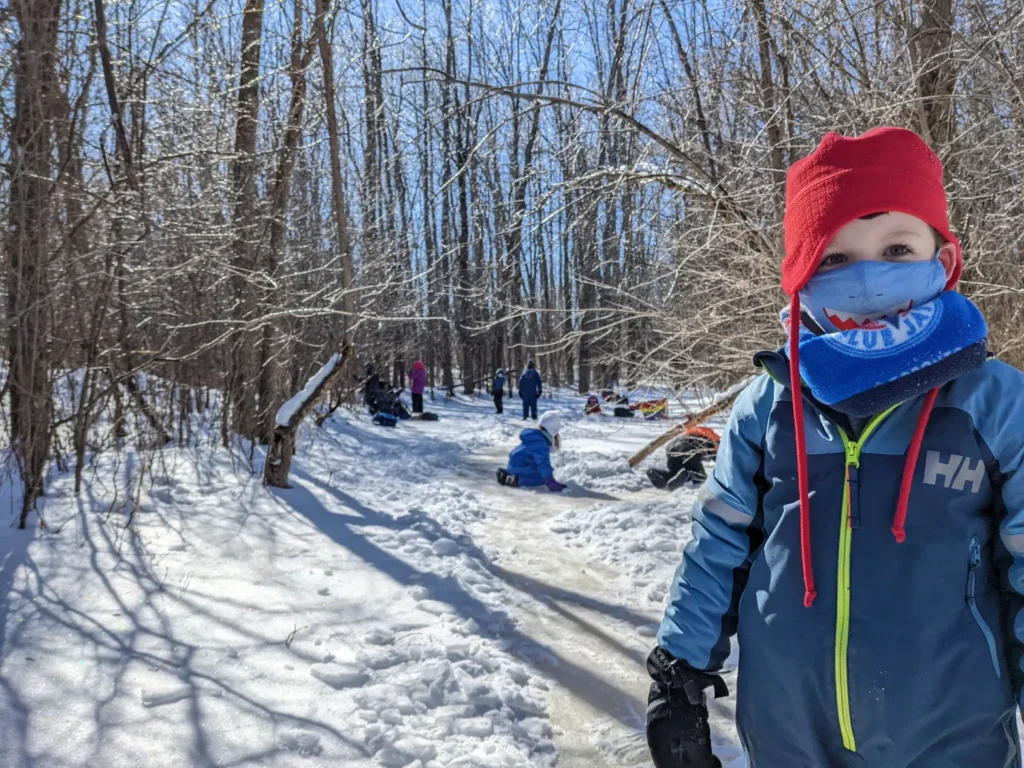Playing with, on and near ice is incredibly inviting. Science and magic combine to offer a type of play that only happens outside when it’s cold- the conversion of life-giving splashy water into crystal, slippery, crunchy, slidey wondrous ice.
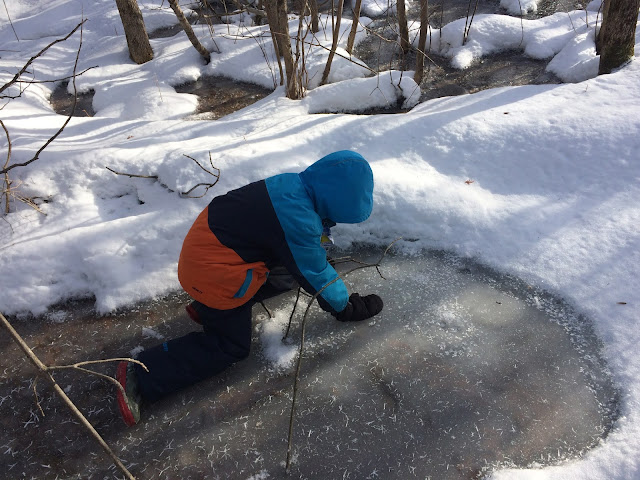
It can feel tricky to say yes to playing on ice. If it is a pond or deep puddle, we worry that it’s not thick enough and that we will crash through, getting soaked. If it is polished and super slippery, we worry that sliding on it will lead to wipeouts- sore knees, back crackers, and head bonks.
I, as well as many of the adults I have encountered in this work, have fond winter memories of play that centred on or near the ice. We remember running and sliding, crunching through puddles on the walk to school, getting soakers inside our winter boots, and seeing frogs incredibly swimming under the ice. It has felt right to make space for this type of play to emerge for the children that I work with, so to find ways to say yes to this kind of play for them, too.
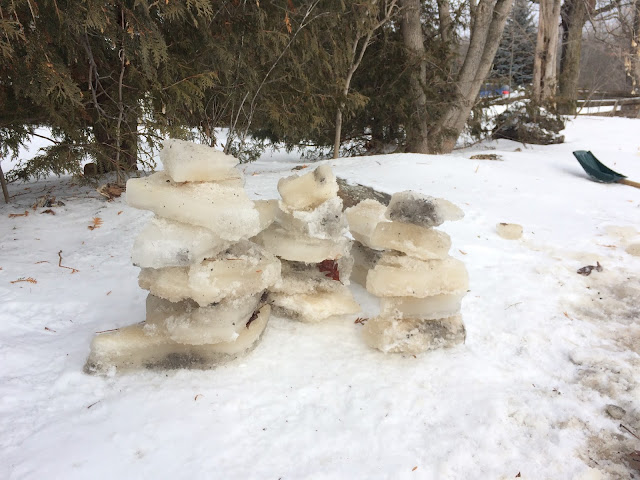
As I mentioned above, when I think about playing with and on ice with children there are 2 types of concerns that arise the most.
What if the ice is thin with water underneath it?
What if we slide on it and get hurt?
We name these concerns directly with the children, work together to make a plan about how to address these concerns, then try it out, with educators near by to hold the space and to step in with reminders or redirections as necessary.

It is essential for children to understand that going out on thin ice on a lake or river is very dangerous. We do not do this with groups and we remind children over and over that if they see ice they need to talk to their grown-ups first before going out on it. The wild spaces where we explore and play in winter at Out to Play are deliberately not near the river, and the creek is flagged off and closed to play where it runs, and we keep an eye on the calmer spots, staying off the ice until we know it can bear the weight of the group.
Once we know the creek is frozen solid, we are likely to explore and play near and on it. We do a considerable amount of prep before going onto that ice with children, or even onto frozen puddles. Here are the steps:
We check how everyone is dressed. If we know there is water under the crunchy ice on the path, we talk about how deep it might be, what kind of boots we’re wearing, how water sneaks in wherever it can to soak our socks and make our feet cold (silly water!). We point out which boots are waterproof only to above the ankles and which are all the way up so children know who can go deeper in puddles if they choose to and still stay dry. We will choose our route across the land based on how cold the air is and how well outfitted the group is.
Staff will visit the site before going there with a group, even if we were there just a few days ago. Conditions in the forest change quickly, especially with freezing and thawing. An area that has thin ice on Friday might be frozen solid on Monday, or vice-versa. It is much smoother to bring children to a Play Zone where they can explore and play freely rather than stopping near a feature, like thin ice on a deep pond, that they will want to play on that we do not feel is safe, so we make plans accordingly and let the children know. I might say “I would also love to visit the Icy Grass Field, but I checked it this morning and the ice broke when I poked it with a stick, so my gut is telling me it is a smarter choice to play somewhere else today. Where shall we go?”

If we have decided to visit a Play Zone where there is thin ice, we gather around it. We poke it with a stick to see if it will break, and if it does, how deep is the water underneath. We already know this water is very shallow, but might still be deep enough to sneak into boots, so we look at it and talk about it. After doing this, we make a decision about whether or not we can play on it. If we decide it doesn’t feel right, we continue moving on to a different location to remove temptation.
I usually tell a story about walking on ice, the ice cracking so water got onto it, and how much more slippery the ice was after that. Depending on the group, I might talk about how ice is more slippery after a zamboni has spread water on it and how that is true in the forest, too, so if the ice gets wet, be ready to slip and slide more. (We might decide to move on or away from that particular spot if the ice is getting wet. We aren’t opposed to children falling and getting back up, but falling into cold water under ice means getting wet which becomes a safety concern.)
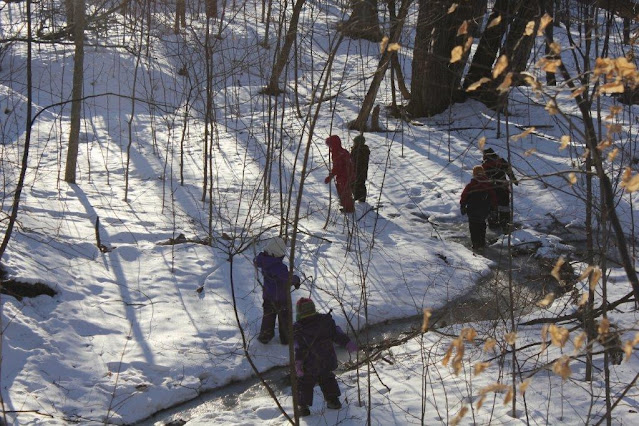
Here’s what we do when we know the ice is thick:
As above, we strive to check the site before visiting. If the weather has been significantly cold with no snow accumulation for a few days, we know we can probably count on ice still being frozen hard.
We have a chat before hiking out, talking about how the ice we might play on is over very shallow water and that if children encounter ice, at home or with us, they need to talk to their grown-ups before going out on it.
We talk about how if there is a lot of snow on ice it probably makes it less slippery, but a light dusting of snow on the ice might make it more slippery, so think about that when choosing where to step.
I model walking and slipping on ice, falling backwards and hitting my head. I ask the children what happened, what I could do differently, how I could protect my head.
I’ll include walking on ice in our morning Story, to give us a reference to look back on. “Remember how Raccoon in our Story was able to scurry across the ice when she was low and on all fours? I want to try that.”
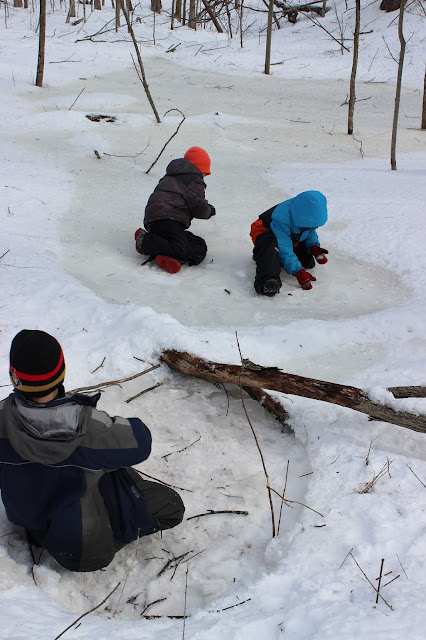
Depending on the group and ice conditions, we might require that all play on the ice happens on all fours, like Raccoon. We might start that way then permit children to try walking crouched, with their arms up for balance. We model this way of walking across an icy patch on the path- arms up and out, body leaning forward so that if we fall it is forward and not back.
I tell children to expect to fall, that it is natural and okay. It might not hurt when they fall, or it might. I tell them that if they fall it is okay to stay down, to catch their breath, then to get up when they are ready to. I tell them I believe in them and I know they are strong and smart, and that if they fall they will be able to get back up and keep going.
If children want to run then slide on the ice, we require that it happens from one location/side of the ice, and one or two at a time, depending on the space. Children must do the running part on the snow.
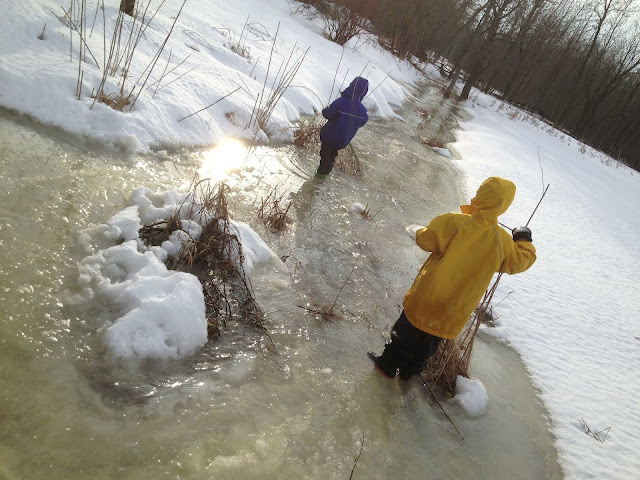
There have been times when a group has struggled to make smart and safe choices on the ice. Sometimes we need to take a break from that play and then reintroduce it at another time in a different way, perhaps making room for just a small group of children to play in the Ice Zone at a time, cycling children through, sometimes stepping away from it altogether until another day and set of weather circumstances makes it feel like a smarter, safer choice.
Often, once we have taken time to talk through the process with children, once they understand we want to say yes as long as we are all making smart choices, and once we have settled into the play, playing on or near ice is truly wonderful.
We wish you joy, luck, and so much fun on your slippy, slidey, crunchy, icy adventures!

